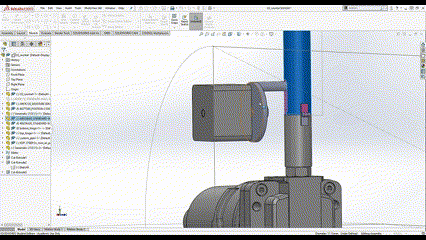Autonomous Underwater Vehicle Design

White Paper: [link]
My Contributions:
-
Concept generation for power systems and oxygen snorkel
-
CAD design and testing of various snorkel concepts (SolidWorks)
-
3D printed snorkel works-like prototype
-
Conducted long-term analysis of on-board power systems
-
Developed electronics schematic of on-board solar power
-
Source materials for solar modules
-
CAD design and sizing of solar modules
-
Contributed to writing the paper

The ocean is a challenging environment. To quote from the original problem statement, “Two-thirds of the earth's surface and 99% of the earth's biosphere, the volume of the earth that supports life, is ocean yet we currently monitor less that 2% of it and we have explored less than 5% of it. Fundamentally, we are blind to what is going on in our own backyard.” In the class, Engineering Systems Design (2.733), from this problem statement, we design an autonomous, unmanned underwater vehicle to detect and monitor algae blooms, oil spills, underwater pipelines, and plastic pollution. Unmanned underwater vehicles provide the best opportunity to collect frequent, long-term, subsurface data of these oceanic events.






Works-like prototype
Alternative concept testing
Aluminum fuel is an experimental option for the storage of hydrogen fuel. The aluminum fuel is stored onboard the vehicle and reacted in small amounts with an excess of seawater to generate hydrogen. To drive the hydrogen electrochemical reaction and generate power for our vehicle, air-containing oxygen must be supplied to the fuel cell at a minimum flow rate of 1.45 L/min. Ensuring we have a reliable flow of air to the fuel cell is critical for the long-term operation of the vehicle. To minimize system weight, volume, and complexity, we down-selected from an array of air-supply and air-storage designs and honed in on a telescoping snorkel that supplies air to the fuel cell during a resurface.
The telescoping snorkel actuates up and down perpendicular to the hull using a simple pulley-motor system. The snorkel serves two key functions: (1) bringing the air tube above the water and wave surface to funnel air into the fuel cell and (2) bringing the antenna to an appropriate height for data transmission. For the snorkel to achieve a height of 12” above the water level, it actuates vertically and perpendicular to the hull when the UUV is resurfaced. To balance the maximizing height requirement and minimizing volume requirement, the snorkel tube is split into four constituent tubes, three of which actuate and one of which is fixed to the fairing.